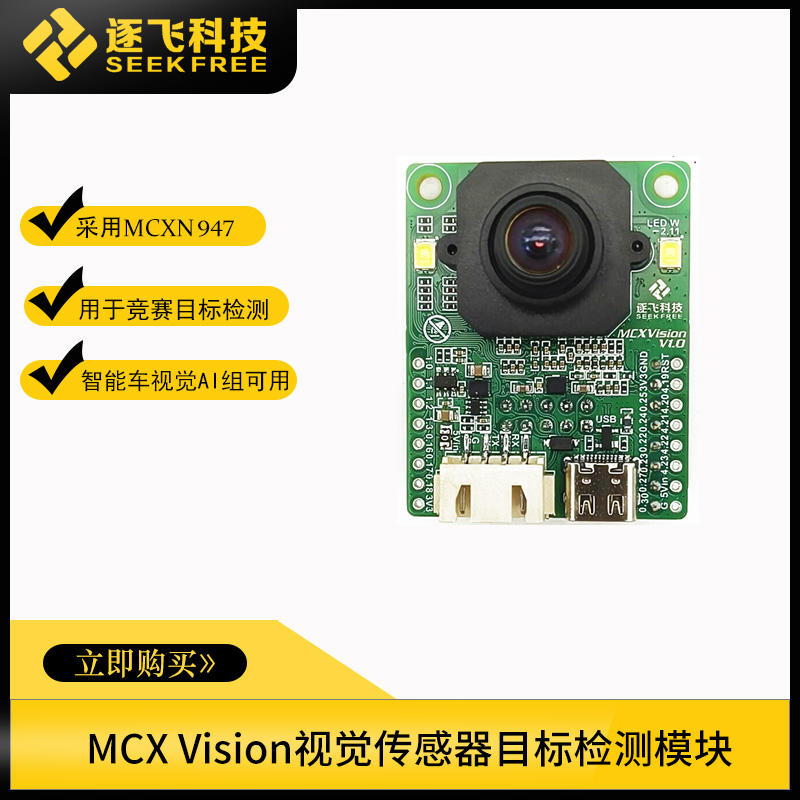# MCX_Vision_Library
**Repository Path**: seekfree/MCX_Vision_Library
## Basic Information
- **Project Name**: MCX_Vision_Library
- **Description**: 逐飞科技基于NXP MCXN947为核心制作的图像处理模块,MCXN947自带NPU单元可以极大提升神经网络相关的计算速度。本开源项目分享了基于MCXN947的部分基础外设例程、以及目标检测从训练到部署的全过程。
- **Primary Language**: C
- **License**: GPL-3.0
- **Default Branch**: master
- **Homepage**: None
- **GVP Project**: No
## Statistics
- **Stars**: 20
- **Forks**: 7
- **Created**: 2024-05-13
- **Last Updated**: 2025-10-03
## Categories & Tags
**Categories**: Uncategorized
**Tags**: None
## README

# MCX_Vision_Library
## 一、介绍
逐飞科技基于NXP MCXN947为核心制作的图像处理模块,MCXN947自带NPU单元可以极大提升神经网络相关的计算速度。本开源项目分享了基于MCXN947的部分基础外设例程、以及目标检测从训练到部署的全过程。
## 二、环境准备
1. **MCX Vision模块**
- 使用本公司开发的MCX Vision模块,购买链接:[点击此处购买](https://item.taobao.com/item.htm?id=786816982538)。
2. **软件环境**
- 安装Keil MDK 5.38a 以及对应的 PACK包
- 如果需要使用目标检测功能还需要安装eIQ,Python软件
3. **仿真器**
- DAP仿真器:推荐使用本公司DAP仿真器,双下载模式,可以在支持的环境下实现更高下载速度。[点击此处购买](https://item.taobao.com/item.htm?id=583404964920)。
## 三、例程使用说明
1. **下载开源库:** 点击页面右侧的克隆/下载按钮,将工程文件保存到本地。您可以使用git克隆(Clone)或下载ZIP压缩包的方式来下载。推荐使用git将工程目录克隆到本地,这样可以使用git随时与我们的开源库保持同步。关于码云与git的使用教程可以参考以下链接 [https://gitee.com/help](https://gitee.com/help)。
2. **打开工程:** 将下载好的工程文件夹打开(若下载的为ZIP文件,请先解压压缩包)。在打开工程前,请务必确保您的IDE满足环境准备章节的要求。否则可能出现打开工程时报错,提示丢失目录信息等问题。
3. **连接下载器:**使用DAP下载器连接MCX Vision,并将下载器连接电脑
4. **下载代码:**使用Keil下载程序,下载完成后进行手动复位,程序开始执行
#### MCX Vision模块

## 四、 模块整体说明
MCXVision模块外观如下:
 ### 4.1、模块主控MCU芯片介绍
如模块名称所示,模块采用NXP的MCX系列MCU芯片,该芯片基于ARM Cortex-M33内核,主频为150MHz,内置512KB的RAM和2MB的Flash存储。尽管主频看似不高,但MCX芯片的SmartDMA外设可以在不占用CPU资源的情况下独立完成摄像头数据的采集,显著提升了数据获取的效率。此外,芯片还集成了NPU(神经网络处理单元),能够高效运行TensorFlow Lite(tflite)模型,进一步增强了模块的AI处理能力。这种设计巧妙地弥补了主频的不足,确保了模块在执行复杂视觉任务时依然能够保持高性能的主线任务。能极大地弥补主频较低的短板。
### 4.1、模块主控MCU芯片介绍
如模块名称所示,模块采用NXP的MCX系列MCU芯片,该芯片基于ARM Cortex-M33内核,主频为150MHz,内置512KB的RAM和2MB的Flash存储。尽管主频看似不高,但MCX芯片的SmartDMA外设可以在不占用CPU资源的情况下独立完成摄像头数据的采集,显著提升了数据获取的效率。此外,芯片还集成了NPU(神经网络处理单元),能够高效运行TensorFlow Lite(tflite)模型,进一步增强了模块的AI处理能力。这种设计巧妙地弥补了主频的不足,确保了模块在执行复杂视觉任务时依然能够保持高性能的主线任务。能极大地弥补主频较低的短板。
 ### 4.2、摄像头模组介绍
MCXVision模块配备了与凌瞳摄像头模组一致的高品质CMOS传感器,该传感器内置了ISP(图像信号处理器)单元,能够直接输出RGB565格式的全彩图像。凌瞳CMOS的高感光性能确保了在标准模式下能够提供精确的色彩,并且通过调整参数,可以切换到鲜艳模式,增强色彩饱和度,从而更易于进行颜色识别和特征检测。
此外,凌瞳CMOS在低光照条件下的表现同样出色,即便在缺乏补光的昏暗环境中,也能捕捉到清晰且细节丰富的图像,噪点控制效果在同类产品中属于领先水平。确保MCXVision模块在多种光照条件下都能提供高质量的视觉数据。
### 4.3、接口介绍

**1、供电接口:**使用TypeC接口输入5V。
**2、XH2.54-4P用户串口接口(串口5):**可以使用这个接口输入5V进行供电,此接口的串口连接其他单片机或者使用TTL连接电脑可进行串口通信。
**3、拓展引脚:**根据需要使用这些引脚作为拓展使用。
**4、闪光灯:**通过程序控制,用于前置补光。
**5、指示灯:**左侧的三色LED通过程序控制,可以作为状态显示。右侧的PWR为电源指示灯,上电会常亮。RDY为内核指示灯,程序正常运行会常亮。上电后没有亮说明内核没有启动,需要重新上电。如果RDY指示灯闪烁,说明程序进入错误报警。
**6、用户按键:**通过程序控制,用于人机交互。
**7、SD卡:**插入SD卡,通过程序实现文件管理。
**8、屏幕接口:**通过此接口连接IPS 2寸SPI屏幕
**9、SWD下载接口:**连接DAP下载器下载程序,这个接口带DEBUG串口(串口4),方便使用下载器进行串口通信调试。
## 五、开源资料说明
Gitee开源资料链接:https://gitee.com/seekfree/MCX_Vision_Library
下载资料压缩包,解压后可以看到如下文件:

1、**【例程】Example**:包含MCXVision各个外设和目标检测的使用例程。
2、**【软件】IDE 上位机 训练脚本**:包含所需的软件、上位机、目标检测训练脚本。其中用到的部分软件体积过大,所以使用百度网盘存放,百度网盘链接如下:
**链接:https://pan.baidu.com/s/1oPnGLCXUUIqJ9OL2jw1Y8g**
**提取码:5k7w**
3、**【文档】说明书 芯片手册等**:包含模块的使用说明书和MCX使用的芯片手册。
4、**【原理图】原理图 丝印图 尺寸图 位号图**:包含MCXVision的尺寸和图片。
## 六、与OpenART mini对比
OpenART mini模块通过使用MicroPython编程语言,利用Python语言的便捷性,能快速完成图像处理相关的任务,其固件内置的图像处理接口能够高效地执行多种图像处理功能。但是,这种便捷性也伴随着一些局限性,比如MicroPython需要先将程序解析成可以执行的代码,导致程序运行效率会有所下降。
MCXVision模块则在一定方面上弥补了这些不足。它采用C/C++作为编程语言,虽然学习难度相对较高,但提供了更高的灵活性和控制力,允许用户自行优化和调整算法,以适应不同的应用需求。MCXVision模块可以作为一个独立的图像处理单元,执行如赛道追踪、边缘检测、色块识别等复杂算法,等于一个图像协处理器,可以减轻主控芯片的负担,提升整体系统的性能,很适合用在今年的图片目标发现这一场景。
OpenART更适合用在分类和识别上,两者因为特点不同从而有不同的适用场景,同学们根据需求来选择使用的模块即可。为了帮助用户更快地掌握MCXVision模块的使用,我们将提供一系列的外设使用示例和应用示例,这些资源将有助于降低入门难度,加快开发进程。
作为NXP本届赛题的新MCU图像处理平台,大家最关心的应该还是运行模型的帧率如何,我们也进行了运行目标检测模型寻找目标板的对比测试:
1、OpenART mini运行的帧率如下(QVGA在5帧左右,QQVGA在8帧左右):

2、MCXVision运行模型的帧率如下(QVGA在20帧左右,QQVGA在30帧左右):

并且,MCX上运行的模型输入大小为160*128,避免了之前在OpenART mini模型只能正方形的图像输入问题。
### 4.2、摄像头模组介绍
MCXVision模块配备了与凌瞳摄像头模组一致的高品质CMOS传感器,该传感器内置了ISP(图像信号处理器)单元,能够直接输出RGB565格式的全彩图像。凌瞳CMOS的高感光性能确保了在标准模式下能够提供精确的色彩,并且通过调整参数,可以切换到鲜艳模式,增强色彩饱和度,从而更易于进行颜色识别和特征检测。
此外,凌瞳CMOS在低光照条件下的表现同样出色,即便在缺乏补光的昏暗环境中,也能捕捉到清晰且细节丰富的图像,噪点控制效果在同类产品中属于领先水平。确保MCXVision模块在多种光照条件下都能提供高质量的视觉数据。
### 4.3、接口介绍

**1、供电接口:**使用TypeC接口输入5V。
**2、XH2.54-4P用户串口接口(串口5):**可以使用这个接口输入5V进行供电,此接口的串口连接其他单片机或者使用TTL连接电脑可进行串口通信。
**3、拓展引脚:**根据需要使用这些引脚作为拓展使用。
**4、闪光灯:**通过程序控制,用于前置补光。
**5、指示灯:**左侧的三色LED通过程序控制,可以作为状态显示。右侧的PWR为电源指示灯,上电会常亮。RDY为内核指示灯,程序正常运行会常亮。上电后没有亮说明内核没有启动,需要重新上电。如果RDY指示灯闪烁,说明程序进入错误报警。
**6、用户按键:**通过程序控制,用于人机交互。
**7、SD卡:**插入SD卡,通过程序实现文件管理。
**8、屏幕接口:**通过此接口连接IPS 2寸SPI屏幕
**9、SWD下载接口:**连接DAP下载器下载程序,这个接口带DEBUG串口(串口4),方便使用下载器进行串口通信调试。
## 五、开源资料说明
Gitee开源资料链接:https://gitee.com/seekfree/MCX_Vision_Library
下载资料压缩包,解压后可以看到如下文件:

1、**【例程】Example**:包含MCXVision各个外设和目标检测的使用例程。
2、**【软件】IDE 上位机 训练脚本**:包含所需的软件、上位机、目标检测训练脚本。其中用到的部分软件体积过大,所以使用百度网盘存放,百度网盘链接如下:
**链接:https://pan.baidu.com/s/1oPnGLCXUUIqJ9OL2jw1Y8g**
**提取码:5k7w**
3、**【文档】说明书 芯片手册等**:包含模块的使用说明书和MCX使用的芯片手册。
4、**【原理图】原理图 丝印图 尺寸图 位号图**:包含MCXVision的尺寸和图片。
## 六、与OpenART mini对比
OpenART mini模块通过使用MicroPython编程语言,利用Python语言的便捷性,能快速完成图像处理相关的任务,其固件内置的图像处理接口能够高效地执行多种图像处理功能。但是,这种便捷性也伴随着一些局限性,比如MicroPython需要先将程序解析成可以执行的代码,导致程序运行效率会有所下降。
MCXVision模块则在一定方面上弥补了这些不足。它采用C/C++作为编程语言,虽然学习难度相对较高,但提供了更高的灵活性和控制力,允许用户自行优化和调整算法,以适应不同的应用需求。MCXVision模块可以作为一个独立的图像处理单元,执行如赛道追踪、边缘检测、色块识别等复杂算法,等于一个图像协处理器,可以减轻主控芯片的负担,提升整体系统的性能,很适合用在今年的图片目标发现这一场景。
OpenART更适合用在分类和识别上,两者因为特点不同从而有不同的适用场景,同学们根据需求来选择使用的模块即可。为了帮助用户更快地掌握MCXVision模块的使用,我们将提供一系列的外设使用示例和应用示例,这些资源将有助于降低入门难度,加快开发进程。
作为NXP本届赛题的新MCU图像处理平台,大家最关心的应该还是运行模型的帧率如何,我们也进行了运行目标检测模型寻找目标板的对比测试:
1、OpenART mini运行的帧率如下(QVGA在5帧左右,QQVGA在8帧左右):

2、MCXVision运行模型的帧率如下(QVGA在20帧左右,QQVGA在30帧左右):

并且,MCX上运行的模型输入大小为160*128,避免了之前在OpenART mini模型只能正方形的图像输入问题。
 ## 七、NPU与模型运行
MCX芯片集成eIQ Neutron神经处理单元,支持CNN、RNN、TCN、Transformer和大多数神经网络类型,能极大的提高模型的运算速度。既然如此我们来看看如何生成NPU专用的模型。详细说明在MCXVision说明书的模型训练章节。
1、安装python3.10.7版本,eIQ1.10.0版本(资料中提供)
2、拍摄目标检测图片,推荐使用OpenART mini进行拍摄,用上一届工具标记好的图片可以直接使用。
3、使用label_img工具标记图片(资料中提供)。
4、在资料中找到模型训练文件夹“Object_detection_training”,将文件夹移动到全英文路径,避免后续运行脚本报错。进入训练脚本文件夹“yolo_nano”。

5、按住shift,鼠标右键点击文件夹空白位置,选择打开。Powershell窗口。

6、在Powershell窗口中依次运行如下的脚本。
```python
#安装库文件
pip install -r .\requirements.txt -i https://pypi.tuna.tsinghua.edu.cn/simple
#转换数据集
python .\voc_convertor.py
#生成预瞄框
python .\kmeans.py
#训练模型
python .\train.py
#验证模型
python .\evaluate.py
```
7、训练完成得到如下模型文件

8、打开eIQ软件,选择model tool。

9、打开刚刚生成的模型

10、点击左上角的三根杠,然后点击Convert,转换成NPU使用的模型。



11、更改导出文件名称为smartcar_used19.tflite,导出到合适的位置,改名是为了后面方便使用。

12、下载MCX资料,在资料中打开目标检测的例程。

13、把模型放到user中,如果已存在就覆盖它,确保名称和这个名称完全相同。

14、打开之前的训练脚本路径,打开里面的c_anchors.txt文件。

15、打开MCXVision的工程,也打开anchors.txt文件,并将刚刚复制的内容粘贴进去。

16、然后编译并下载程序即可运行训练好的模型,下载完程序后需要手动复位。
## 结束语
最后祝所有小伙伴都能在第十九届视觉组的比赛中取得满意成绩。也欢迎通过QQ群与车友们进行交流讨论(视觉组交流群①:946236488,视觉组交流群②:706938568)。也欢迎各位持续关注“逐飞科技”微信公众号,逐飞的开源项目、技术分享及智能车竞赛的相关信息更新都会在该公众号上发布,识别下方二维码即可关注。

## 七、NPU与模型运行
MCX芯片集成eIQ Neutron神经处理单元,支持CNN、RNN、TCN、Transformer和大多数神经网络类型,能极大的提高模型的运算速度。既然如此我们来看看如何生成NPU专用的模型。详细说明在MCXVision说明书的模型训练章节。
1、安装python3.10.7版本,eIQ1.10.0版本(资料中提供)
2、拍摄目标检测图片,推荐使用OpenART mini进行拍摄,用上一届工具标记好的图片可以直接使用。
3、使用label_img工具标记图片(资料中提供)。
4、在资料中找到模型训练文件夹“Object_detection_training”,将文件夹移动到全英文路径,避免后续运行脚本报错。进入训练脚本文件夹“yolo_nano”。

5、按住shift,鼠标右键点击文件夹空白位置,选择打开。Powershell窗口。

6、在Powershell窗口中依次运行如下的脚本。
```python
#安装库文件
pip install -r .\requirements.txt -i https://pypi.tuna.tsinghua.edu.cn/simple
#转换数据集
python .\voc_convertor.py
#生成预瞄框
python .\kmeans.py
#训练模型
python .\train.py
#验证模型
python .\evaluate.py
```
7、训练完成得到如下模型文件

8、打开eIQ软件,选择model tool。

9、打开刚刚生成的模型

10、点击左上角的三根杠,然后点击Convert,转换成NPU使用的模型。



11、更改导出文件名称为smartcar_used19.tflite,导出到合适的位置,改名是为了后面方便使用。

12、下载MCX资料,在资料中打开目标检测的例程。

13、把模型放到user中,如果已存在就覆盖它,确保名称和这个名称完全相同。

14、打开之前的训练脚本路径,打开里面的c_anchors.txt文件。

15、打开MCXVision的工程,也打开anchors.txt文件,并将刚刚复制的内容粘贴进去。

16、然后编译并下载程序即可运行训练好的模型,下载完程序后需要手动复位。
## 结束语
最后祝所有小伙伴都能在第十九届视觉组的比赛中取得满意成绩。也欢迎通过QQ群与车友们进行交流讨论(视觉组交流群①:946236488,视觉组交流群②:706938568)。也欢迎各位持续关注“逐飞科技”微信公众号,逐飞的开源项目、技术分享及智能车竞赛的相关信息更新都会在该公众号上发布,识别下方二维码即可关注。
 ### 4.1、模块主控MCU芯片介绍
如模块名称所示,模块采用NXP的MCX系列MCU芯片,该芯片基于ARM Cortex-M33内核,主频为150MHz,内置512KB的RAM和2MB的Flash存储。尽管主频看似不高,但MCX芯片的SmartDMA外设可以在不占用CPU资源的情况下独立完成摄像头数据的采集,显著提升了数据获取的效率。此外,芯片还集成了NPU(神经网络处理单元),能够高效运行TensorFlow Lite(tflite)模型,进一步增强了模块的AI处理能力。这种设计巧妙地弥补了主频的不足,确保了模块在执行复杂视觉任务时依然能够保持高性能的主线任务。能极大地弥补主频较低的短板。
### 4.1、模块主控MCU芯片介绍
如模块名称所示,模块采用NXP的MCX系列MCU芯片,该芯片基于ARM Cortex-M33内核,主频为150MHz,内置512KB的RAM和2MB的Flash存储。尽管主频看似不高,但MCX芯片的SmartDMA外设可以在不占用CPU资源的情况下独立完成摄像头数据的采集,显著提升了数据获取的效率。此外,芯片还集成了NPU(神经网络处理单元),能够高效运行TensorFlow Lite(tflite)模型,进一步增强了模块的AI处理能力。这种设计巧妙地弥补了主频的不足,确保了模块在执行复杂视觉任务时依然能够保持高性能的主线任务。能极大地弥补主频较低的短板。
 ### 4.2、摄像头模组介绍
MCXVision模块配备了与凌瞳摄像头模组一致的高品质CMOS传感器,该传感器内置了ISP(图像信号处理器)单元,能够直接输出RGB565格式的全彩图像。凌瞳CMOS的高感光性能确保了在标准模式下能够提供精确的色彩,并且通过调整参数,可以切换到鲜艳模式,增强色彩饱和度,从而更易于进行颜色识别和特征检测。
此外,凌瞳CMOS在低光照条件下的表现同样出色,即便在缺乏补光的昏暗环境中,也能捕捉到清晰且细节丰富的图像,噪点控制效果在同类产品中属于领先水平。确保MCXVision模块在多种光照条件下都能提供高质量的视觉数据。
### 4.3、接口介绍

**1、供电接口:**使用TypeC接口输入5V。
**2、XH2.54-4P用户串口接口(串口5):**可以使用这个接口输入5V进行供电,此接口的串口连接其他单片机或者使用TTL连接电脑可进行串口通信。
**3、拓展引脚:**根据需要使用这些引脚作为拓展使用。
**4、闪光灯:**通过程序控制,用于前置补光。
**5、指示灯:**左侧的三色LED通过程序控制,可以作为状态显示。右侧的PWR为电源指示灯,上电会常亮。RDY为内核指示灯,程序正常运行会常亮。上电后没有亮说明内核没有启动,需要重新上电。如果RDY指示灯闪烁,说明程序进入错误报警。
**6、用户按键:**通过程序控制,用于人机交互。
**7、SD卡:**插入SD卡,通过程序实现文件管理。
**8、屏幕接口:**通过此接口连接IPS 2寸SPI屏幕
**9、SWD下载接口:**连接DAP下载器下载程序,这个接口带DEBUG串口(串口4),方便使用下载器进行串口通信调试。
## 五、开源资料说明
Gitee开源资料链接:https://gitee.com/seekfree/MCX_Vision_Library
下载资料压缩包,解压后可以看到如下文件:

1、**【例程】Example**:包含MCXVision各个外设和目标检测的使用例程。
2、**【软件】IDE 上位机 训练脚本**:包含所需的软件、上位机、目标检测训练脚本。其中用到的部分软件体积过大,所以使用百度网盘存放,百度网盘链接如下:
**链接:https://pan.baidu.com/s/1oPnGLCXUUIqJ9OL2jw1Y8g**
**提取码:5k7w**
3、**【文档】说明书 芯片手册等**:包含模块的使用说明书和MCX使用的芯片手册。
4、**【原理图】原理图 丝印图 尺寸图 位号图**:包含MCXVision的尺寸和图片。
## 六、与OpenART mini对比
OpenART mini模块通过使用MicroPython编程语言,利用Python语言的便捷性,能快速完成图像处理相关的任务,其固件内置的图像处理接口能够高效地执行多种图像处理功能。但是,这种便捷性也伴随着一些局限性,比如MicroPython需要先将程序解析成可以执行的代码,导致程序运行效率会有所下降。
MCXVision模块则在一定方面上弥补了这些不足。它采用C/C++作为编程语言,虽然学习难度相对较高,但提供了更高的灵活性和控制力,允许用户自行优化和调整算法,以适应不同的应用需求。MCXVision模块可以作为一个独立的图像处理单元,执行如赛道追踪、边缘检测、色块识别等复杂算法,等于一个图像协处理器,可以减轻主控芯片的负担,提升整体系统的性能,很适合用在今年的图片目标发现这一场景。
OpenART更适合用在分类和识别上,两者因为特点不同从而有不同的适用场景,同学们根据需求来选择使用的模块即可。为了帮助用户更快地掌握MCXVision模块的使用,我们将提供一系列的外设使用示例和应用示例,这些资源将有助于降低入门难度,加快开发进程。
作为NXP本届赛题的新MCU图像处理平台,大家最关心的应该还是运行模型的帧率如何,我们也进行了运行目标检测模型寻找目标板的对比测试:
1、OpenART mini运行的帧率如下(QVGA在5帧左右,QQVGA在8帧左右):

2、MCXVision运行模型的帧率如下(QVGA在20帧左右,QQVGA在30帧左右):

并且,MCX上运行的模型输入大小为160*128,避免了之前在OpenART mini模型只能正方形的图像输入问题。
### 4.2、摄像头模组介绍
MCXVision模块配备了与凌瞳摄像头模组一致的高品质CMOS传感器,该传感器内置了ISP(图像信号处理器)单元,能够直接输出RGB565格式的全彩图像。凌瞳CMOS的高感光性能确保了在标准模式下能够提供精确的色彩,并且通过调整参数,可以切换到鲜艳模式,增强色彩饱和度,从而更易于进行颜色识别和特征检测。
此外,凌瞳CMOS在低光照条件下的表现同样出色,即便在缺乏补光的昏暗环境中,也能捕捉到清晰且细节丰富的图像,噪点控制效果在同类产品中属于领先水平。确保MCXVision模块在多种光照条件下都能提供高质量的视觉数据。
### 4.3、接口介绍

**1、供电接口:**使用TypeC接口输入5V。
**2、XH2.54-4P用户串口接口(串口5):**可以使用这个接口输入5V进行供电,此接口的串口连接其他单片机或者使用TTL连接电脑可进行串口通信。
**3、拓展引脚:**根据需要使用这些引脚作为拓展使用。
**4、闪光灯:**通过程序控制,用于前置补光。
**5、指示灯:**左侧的三色LED通过程序控制,可以作为状态显示。右侧的PWR为电源指示灯,上电会常亮。RDY为内核指示灯,程序正常运行会常亮。上电后没有亮说明内核没有启动,需要重新上电。如果RDY指示灯闪烁,说明程序进入错误报警。
**6、用户按键:**通过程序控制,用于人机交互。
**7、SD卡:**插入SD卡,通过程序实现文件管理。
**8、屏幕接口:**通过此接口连接IPS 2寸SPI屏幕
**9、SWD下载接口:**连接DAP下载器下载程序,这个接口带DEBUG串口(串口4),方便使用下载器进行串口通信调试。
## 五、开源资料说明
Gitee开源资料链接:https://gitee.com/seekfree/MCX_Vision_Library
下载资料压缩包,解压后可以看到如下文件:

1、**【例程】Example**:包含MCXVision各个外设和目标检测的使用例程。
2、**【软件】IDE 上位机 训练脚本**:包含所需的软件、上位机、目标检测训练脚本。其中用到的部分软件体积过大,所以使用百度网盘存放,百度网盘链接如下:
**链接:https://pan.baidu.com/s/1oPnGLCXUUIqJ9OL2jw1Y8g**
**提取码:5k7w**
3、**【文档】说明书 芯片手册等**:包含模块的使用说明书和MCX使用的芯片手册。
4、**【原理图】原理图 丝印图 尺寸图 位号图**:包含MCXVision的尺寸和图片。
## 六、与OpenART mini对比
OpenART mini模块通过使用MicroPython编程语言,利用Python语言的便捷性,能快速完成图像处理相关的任务,其固件内置的图像处理接口能够高效地执行多种图像处理功能。但是,这种便捷性也伴随着一些局限性,比如MicroPython需要先将程序解析成可以执行的代码,导致程序运行效率会有所下降。
MCXVision模块则在一定方面上弥补了这些不足。它采用C/C++作为编程语言,虽然学习难度相对较高,但提供了更高的灵活性和控制力,允许用户自行优化和调整算法,以适应不同的应用需求。MCXVision模块可以作为一个独立的图像处理单元,执行如赛道追踪、边缘检测、色块识别等复杂算法,等于一个图像协处理器,可以减轻主控芯片的负担,提升整体系统的性能,很适合用在今年的图片目标发现这一场景。
OpenART更适合用在分类和识别上,两者因为特点不同从而有不同的适用场景,同学们根据需求来选择使用的模块即可。为了帮助用户更快地掌握MCXVision模块的使用,我们将提供一系列的外设使用示例和应用示例,这些资源将有助于降低入门难度,加快开发进程。
作为NXP本届赛题的新MCU图像处理平台,大家最关心的应该还是运行模型的帧率如何,我们也进行了运行目标检测模型寻找目标板的对比测试:
1、OpenART mini运行的帧率如下(QVGA在5帧左右,QQVGA在8帧左右):

2、MCXVision运行模型的帧率如下(QVGA在20帧左右,QQVGA在30帧左右):

并且,MCX上运行的模型输入大小为160*128,避免了之前在OpenART mini模型只能正方形的图像输入问题。
 ## 七、NPU与模型运行
MCX芯片集成eIQ Neutron神经处理单元,支持CNN、RNN、TCN、Transformer和大多数神经网络类型,能极大的提高模型的运算速度。既然如此我们来看看如何生成NPU专用的模型。详细说明在MCXVision说明书的模型训练章节。
1、安装python3.10.7版本,eIQ1.10.0版本(资料中提供)
2、拍摄目标检测图片,推荐使用OpenART mini进行拍摄,用上一届工具标记好的图片可以直接使用。
3、使用label_img工具标记图片(资料中提供)。
4、在资料中找到模型训练文件夹“Object_detection_training”,将文件夹移动到全英文路径,避免后续运行脚本报错。进入训练脚本文件夹“yolo_nano”。

5、按住shift,鼠标右键点击文件夹空白位置,选择打开。Powershell窗口。

6、在Powershell窗口中依次运行如下的脚本。
```python
#安装库文件
pip install -r .\requirements.txt -i https://pypi.tuna.tsinghua.edu.cn/simple
#转换数据集
python .\voc_convertor.py
#生成预瞄框
python .\kmeans.py
#训练模型
python .\train.py
#验证模型
python .\evaluate.py
```
7、训练完成得到如下模型文件

8、打开eIQ软件,选择model tool。

9、打开刚刚生成的模型

10、点击左上角的三根杠,然后点击Convert,转换成NPU使用的模型。



11、更改导出文件名称为smartcar_used19.tflite,导出到合适的位置,改名是为了后面方便使用。

12、下载MCX资料,在资料中打开目标检测的例程。

13、把模型放到user中,如果已存在就覆盖它,确保名称和这个名称完全相同。

14、打开之前的训练脚本路径,打开里面的c_anchors.txt文件。

15、打开MCXVision的工程,也打开anchors.txt文件,并将刚刚复制的内容粘贴进去。

16、然后编译并下载程序即可运行训练好的模型,下载完程序后需要手动复位。
## 结束语
最后祝所有小伙伴都能在第十九届视觉组的比赛中取得满意成绩。也欢迎通过QQ群与车友们进行交流讨论(视觉组交流群①:946236488,视觉组交流群②:706938568)。也欢迎各位持续关注“逐飞科技”微信公众号,逐飞的开源项目、技术分享及智能车竞赛的相关信息更新都会在该公众号上发布,识别下方二维码即可关注。

## 七、NPU与模型运行
MCX芯片集成eIQ Neutron神经处理单元,支持CNN、RNN、TCN、Transformer和大多数神经网络类型,能极大的提高模型的运算速度。既然如此我们来看看如何生成NPU专用的模型。详细说明在MCXVision说明书的模型训练章节。
1、安装python3.10.7版本,eIQ1.10.0版本(资料中提供)
2、拍摄目标检测图片,推荐使用OpenART mini进行拍摄,用上一届工具标记好的图片可以直接使用。
3、使用label_img工具标记图片(资料中提供)。
4、在资料中找到模型训练文件夹“Object_detection_training”,将文件夹移动到全英文路径,避免后续运行脚本报错。进入训练脚本文件夹“yolo_nano”。

5、按住shift,鼠标右键点击文件夹空白位置,选择打开。Powershell窗口。

6、在Powershell窗口中依次运行如下的脚本。
```python
#安装库文件
pip install -r .\requirements.txt -i https://pypi.tuna.tsinghua.edu.cn/simple
#转换数据集
python .\voc_convertor.py
#生成预瞄框
python .\kmeans.py
#训练模型
python .\train.py
#验证模型
python .\evaluate.py
```
7、训练完成得到如下模型文件

8、打开eIQ软件,选择model tool。

9、打开刚刚生成的模型

10、点击左上角的三根杠,然后点击Convert,转换成NPU使用的模型。



11、更改导出文件名称为smartcar_used19.tflite,导出到合适的位置,改名是为了后面方便使用。

12、下载MCX资料,在资料中打开目标检测的例程。

13、把模型放到user中,如果已存在就覆盖它,确保名称和这个名称完全相同。

14、打开之前的训练脚本路径,打开里面的c_anchors.txt文件。

15、打开MCXVision的工程,也打开anchors.txt文件,并将刚刚复制的内容粘贴进去。

16、然后编译并下载程序即可运行训练好的模型,下载完程序后需要手动复位。
## 结束语
最后祝所有小伙伴都能在第十九届视觉组的比赛中取得满意成绩。也欢迎通过QQ群与车友们进行交流讨论(视觉组交流群①:946236488,视觉组交流群②:706938568)。也欢迎各位持续关注“逐飞科技”微信公众号,逐飞的开源项目、技术分享及智能车竞赛的相关信息更新都会在该公众号上发布,识别下方二维码即可关注。
